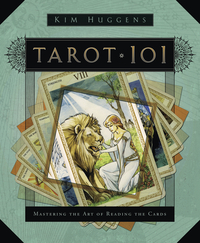Shuffling and Mission Statements
Tarot shelves at bookstores are filled with beginner level books. Do we really need so many? Aren’t they all essentially the same?
I think we do need so many and that they are not essentially the same. First, they all differ in terms of voice and presentation. People learn differently and respond better to some styles of communication than to others. Every author has his or her own voice and way of explaining things. Second, not every tarot reader interprets or reads the cards in the same way. By seeing that there are so many different methods and schools of thought, new readers are encouraged to explore until they find what works for them.
This month we will look at eight different books that might be appropriate for beginners. Today’s book is Tarot 101 by Kim Huggens.
This is one of my favorite new beginner books. I love the way this book shakes things up! Instead of presenting the Major Arcana in numerical order, they are grouped according to theme, such as Feminine Archetypes (High Priestess, Empress, and Star), Virtues and Vices (Justice, Strength, Temperance), and the Dark Side (Hanged Man, Tower, and Devil). This technique allows the newbie to notice similarities and differences among the cards.
As you may guess by the title, this book is set up like a class, so it is great for the reader who likes an interactive, hands-on approach (and it is also great as a basis for a class). There are exercises to do for each lesson as well as optional homework and further reading. So the reader develops a very strong foundation coupled with the skills to think and decide things for him or herself about the tarot as well as receiving guidance for pursuing special interests further.
Tarot 101 covers everything, and I mean everything, that a new reader might need to know. For example, shuffling. I never knew how many people didn’t know how to shuffle until I started reading for clients. Tarot 101 has a section on shuffling, including some homework for those who are not comfortable with shuffling:
Make a promise to yourself that you will try to shuffle your cards at least once a day for a few minutes. The more you shuffle the deck, the better you will be at it shuffling—avoiding any embarrassing mishaps with the cards during a reading.
There are more challenging tasks, too, such as creating a personal mission statement:
Take a few minutes to note in a journal your reasons for doing this course. You can be as poetic or as straightforward as you like, but try to think of this exercise as a way of creating a mission statement. Consider what you want to have learned and to be able to do by the end of the course. Reflect upon what aspects of tarot’s many uses most appeal to you…. Keep this mission statement somewhere you will have access to it every time you begin a new lesson in this course, and return to it every few lessons to check that it is still valid. As you go through the course, you may find your ideas changing and evolving, so be aware that the mission statement may require a little revision as your understanding deepen.
A reader who diligently works through this book can conceivably go from beginner to professional. Not just by reading it, but by doing it.











[…] This post was mentioned on Twitter by Cat 'N Owl, Tarot Fans. Tarot Fans said: Tarot Pathways: Shuffling and Mission Statements http://bit.ly/9lE9n0 (via @barbaramoore) […]